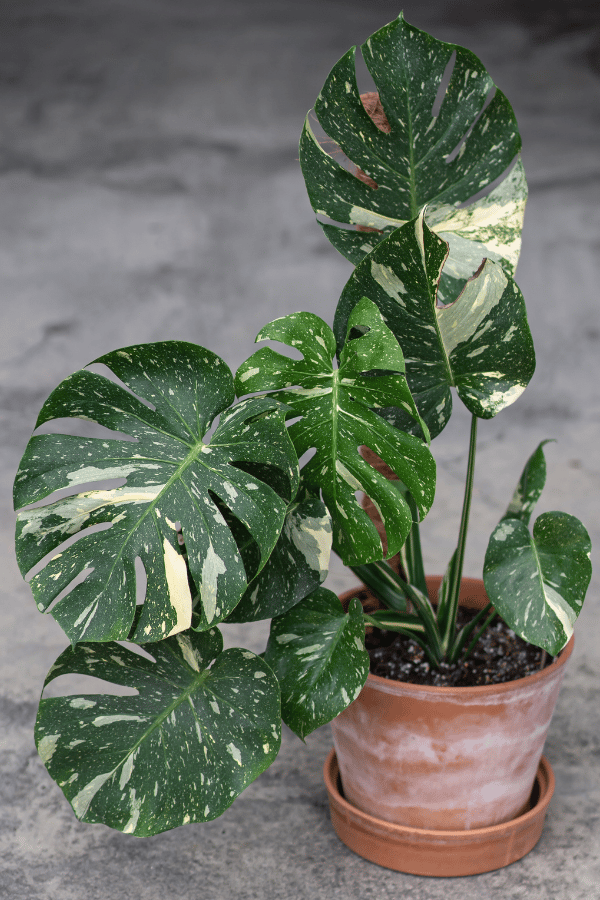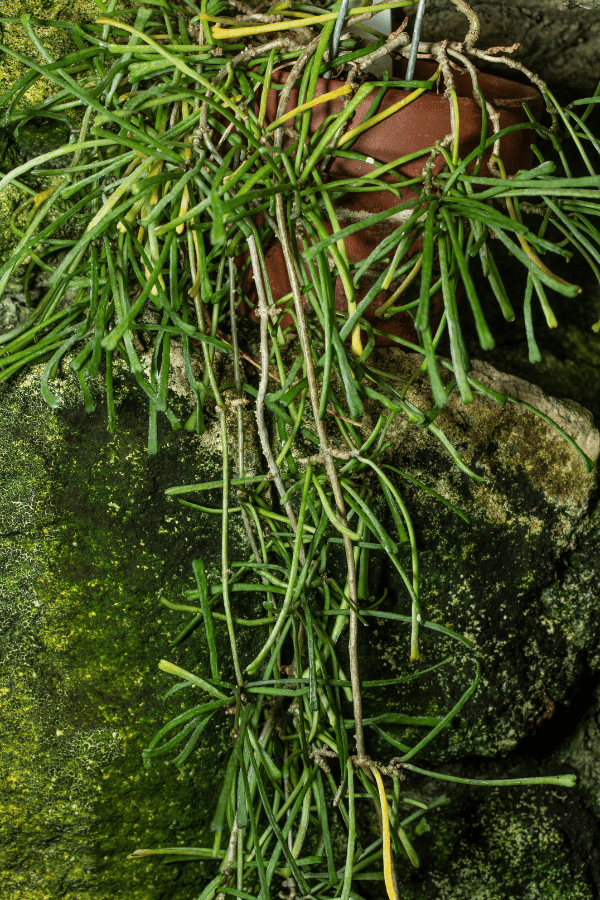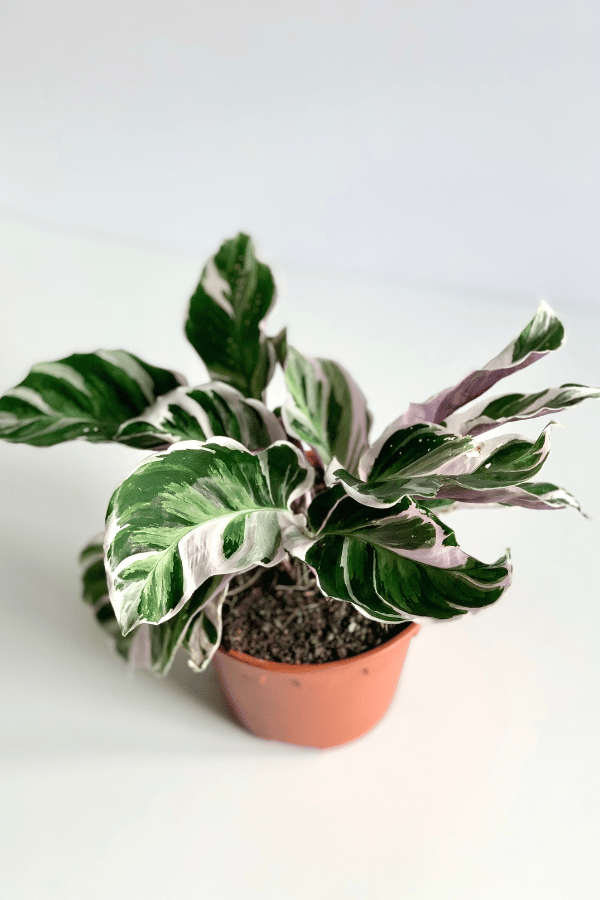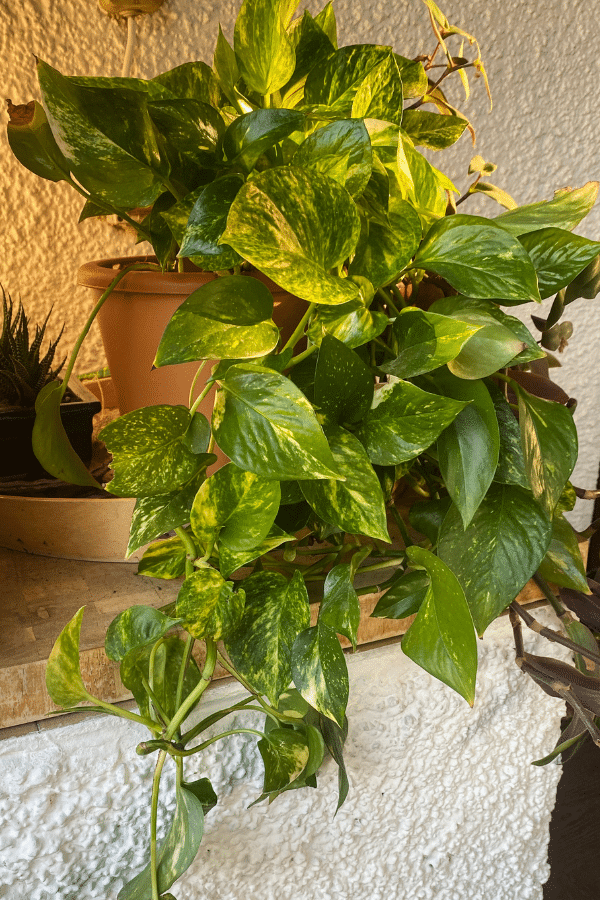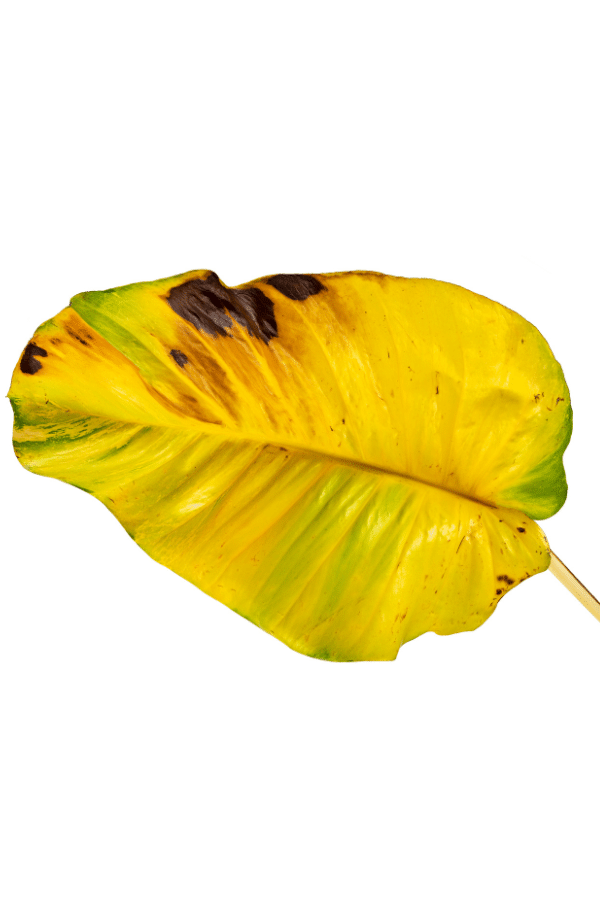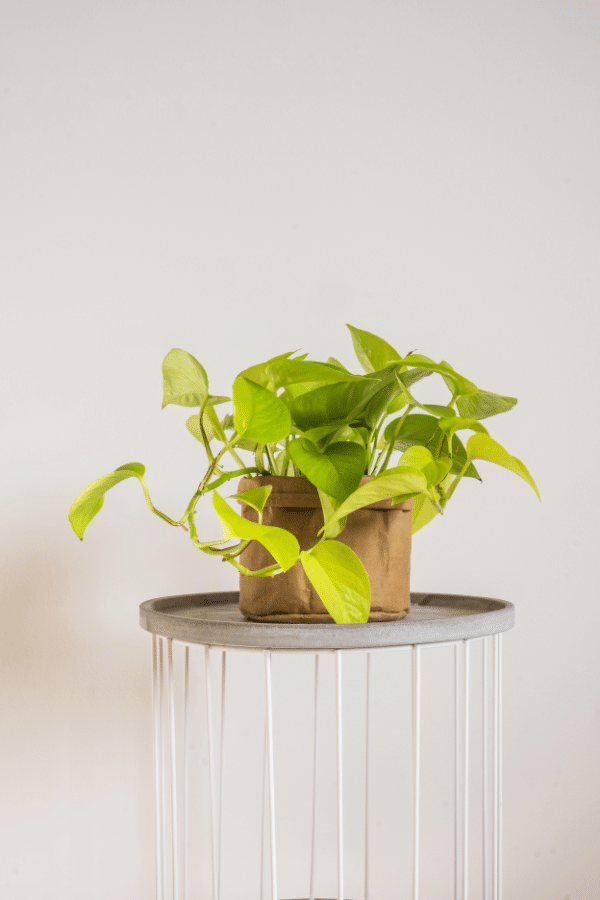Alocasia Hilo Beauty
Scientific Name: Caladium Praetermissum
Common Name: Alocasia Hilo Beauty
Alocasia Hilo Beauty care is easy as it doesn’t require much maintenance, just be sure to provide it with warmer temperatures. This Hilo Beauty plant will provide a unique aspect to your home, read our complete Alocasia Hilo Beauty care guide to see if this plant is right for you and your space.
To give this Alocasia/Caladium plant the best care, it requires well-draining soil that is able to retain water, keep soil moist by watering often, provide it with bright indirect sunlight, and provide it with high temperatures ranging from 80-85F to avoid dormancy.
Quick Care Overview
| Common Name | Alocasia Hilo Beauty, Elephant Ear |
| Scientific Name | Caladium Praetermissum |
| Family | Araceae |
| Origin | Tropical America |
| Growth Rate | Medium |
| Identification | Black stems with white and green heart-shaped leaves |
| Height | Up to 4 feet tall |
| Soil | Well-draining soil that can retain water |
| Water | Allow top two inches to dryout before watering |
| Temperature | 80-85F |
| Sunlight | Bright indirect sunlight |
| Toxic to Cats & Dogs | Yes |
| Toxic to Humans | Yes |
| Pests | Aphids, scale, spider mites, mealybugs |
| Diseases | Root rot |
Below we will dive deep into this Alocasia Hilo Beauty care guide.
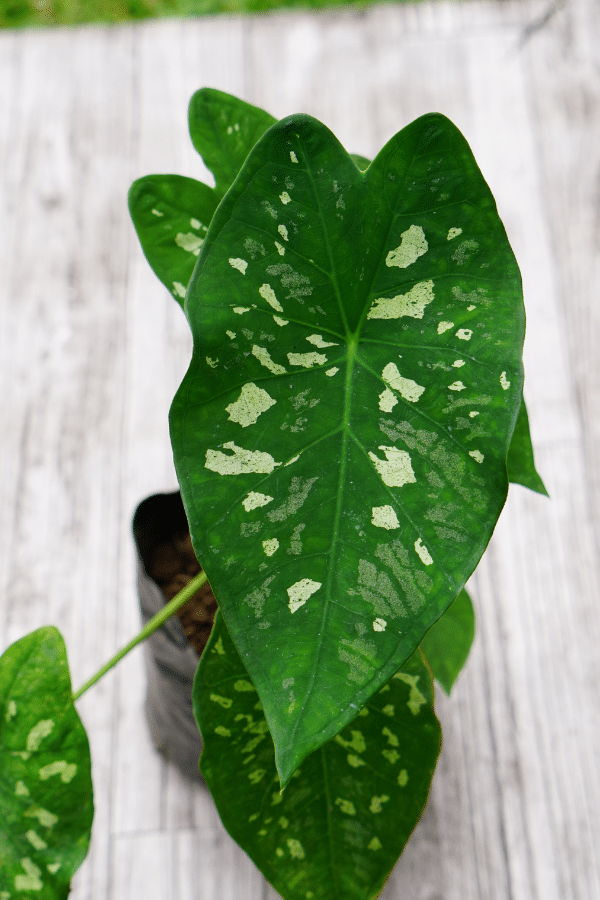
Alocasia Hilo Beauty History
Hawaiian native Alocasia Hilo Beauty is a stunning tropical plant that is a favorite amongst experienced plant owners. There has been some discussion about whether this plant should be classified as a Caladium rather than an Alocasia. The scientific name for this species remains Caladium Praetermissum. Also known as the Elephant Ear, this large-leafed plant is thought to come from the Hilo region of Hawaii.
Alocasia Hilo Beauty Identification
Alocasia Hilo Beauty is a gorgeous, ornamental, evergreen perennial plant with unique black stems with a bluish hue and lovely variegated large heart-shaped leaves. Each leaf is mottled with varying shades of lime green, white, and camouflage-looking blotches.
Alocasia Hilo Beauty Growth Facts
This tropical plant grows and fills out quickly bringing a bit of a jungle oasis feeling to the home.
How Big Does an Alocasia Hilo Beauty Get?
This plant may grow up to 4 feet tall when grown indoors. Leaves may grow up to 3 feet.
Alocasia Hilo Beauty Care
This easy to grow plant doesn’t require much maintenance to be happy. Just ensure that you provide it with a well-draining soil, warmth, humidity, and that its water and light requirements are met.
Searching for a new houseplant?
Take our houseplant quiz to see what your next plant should be based on the room it’s in, the specific lighting the room receives, if you want it on the floor or on the table, and much more!
Alocasia Hilo Beauty Soil
The Alocasia Hilo Beauty requires airy, well-draining, slightly acidic soil that has the ability to retain water. A 1:1:1 mixture of peat moss or coco coir to coarse sand and potting mix will be perfect for this plant. Keep the soil moist at all times as this plant likes consistent moisture rather than allowing the soil to dry out completely.
Alocasia Hilo Beauty Fertilizer
As this Alocasia grows extremely large and may be considered a heavy feeder, it requires frequent feeding throughout the growing season to remain healthy. Select a balanced liquid fertilizer with an NPK ratio of 20-10-10 and feed monthly throughout spring and summer, ensuring that you follow all label instructions. Do not overfertilize or feed in the winter, as this may cause issues, such as chemical burn. If you see signs of over-fertilization, stop fertilizing immediately.
Alocasia Hilo Beauty Watering
As a tropical plant, this Alocasia likes to remain frequently moist but not oversaturated with water. Overwatering can cause severe damage to this plant. The top 1-2″ of soil should dry out before rewatering. Watering frequency should be reduced in winter. Overly soggy soil may make this Alocasia susceptible to fungal diseases.
Alocasia Hilo Beauty Light Requirements
Like many other tropical plants, ‘Hilo Beauty’ likes to have access to bright indirect sunlight throughout the day, emulating the dappled sunlight they might receive from the forest floor of a tropical region such as Hawaii. Direct sunlight should be limited to the morning hours, as too much direct sun will cause leaf scorching. Light from a southern-facing window is perfect for this plant.
Alocasia Hilo Beauty Temperature & Humidity
As this plant hails from a warm tropical region, it likes to be grown in similar warm and humid environments. This Alocasia favors above-average temperatures above 85 degrees Fahrenheit. One of the most important factors playing into the success of growing this plant is keeping it warm. If temperatures go below 80 degrees Fahrenheit, this plant has a tendency to go relatively dormant. This plant will suffer damage if exposed to temperatures below 60 degrees Fahrenheit. Still, some varieties have the capacity to die back during colder weather and then begin regrowth after warmer temperatures.
Additionally, this plant requires a very humid environment and above-average home humidity levels. Therefore, raising your home’s humidity is imperative to growing this plant. Installing a humidifier or pebble tray is suggested. However, misting this plant is not recommended, misting doesn’t do too much to raise humidity levels and some plants do not like getting their leaves wet. Keep this plant away from AC units, heaters, drafts, and cold windows to avoid sudden temperature fluctuations.
Repotting Alocasia Hilo Beauty
Alocasia Hilo Beauty should be repotted every few years when roots are seen sticking out from its container’s drainage holes or you can see the roots on top of the soil. Always go one size up when repotting your plant, which is usually a pot that is 2 inches bigger in diameter. For example, if your Alocasia is in a 4″ pot, go to a 6″ pot when it’s time for a repotting. Going too much bigger in size may induce dormancy because it’s a lot of room for the roots to expand and it will take much longer to produce foliar growth.
Alocasia Hilo Beauty Maintenance & Pruning
This Alocasia does not require much pruning. However, to maintain your plant’s health, any discolored, diseased, or dead leaves should be removed periodically as needed. In addition, ensure that you utilize clean, sterilized shears or a sterile blade to prevent the spread of disease.
Alocasia Hilo Beauty Propagation
Alocasia Hilo Beauty may be easily propagated through either rhizome division, offsets, or stem cuttings. Propagation should be done in spring to allow the new plant babies to grow during the active growing months.

Alocasia Hilo Beauty Toxicity
Alocasia Hilo Beauty is toxic to humans, cats, and dogs. Wash hands after handling this plant and do not ingest.
Toxicity to Humans
Alocasia Hilo Beauty is considered toxic to humans and should never be ingested. This plant contains calcium oxalate crystals which may cause swelling, irritation, and GI issues. Do not consume any portion of this plant.
Toxicity to Cats & Dogs
This Alocasia is considered toxic to pets and should be kept out of their reach. If you suspect that your pet has consumed any portion of this plant, contact your veterinarian or animal poison control immediately.
Alocasia Hilo Beauty Problems
Alocasia Hilo Beauty Leaves Turning Yellow
Yellowing of the leaves may occur when this plant is being overwatered or not receiving enough light.
Alocasia Hilo Beauty Leaves Turning Brown
The most frequent cause of foliage turning brown with Alocasia Hilo Beauty is due to underwatering or not enough humidity.
Alocasia Hilo Beauty Diseases
This Alocasia is considered relatively disease resistant. However, overwatering, and wet leaves may lead to fungal infection. Do not overwater your Alocasia and ensure that your container and soil provide ample drainage. The leaves of this plant should not be misted or watered directly. Upon identifying diseases, isolate your plant and treat it with a fungicide.
Alocasia Hilo Beauty Pests
Hilo Beauty is considered relatively pest resistant. However, like many other indoor houseplants, occasionally, they may become susceptible to infestation by scale, aphids, spider mites, and mealybugs. Upon identifying an infestation, isolate your plant, and treat it with insecticidal soap or neem oil.

